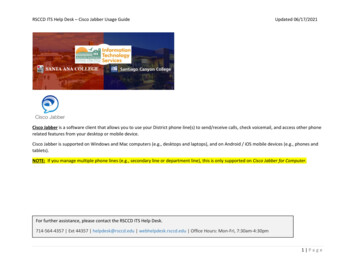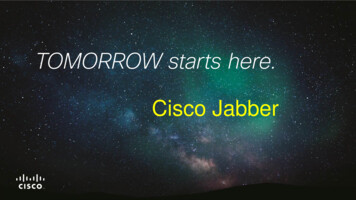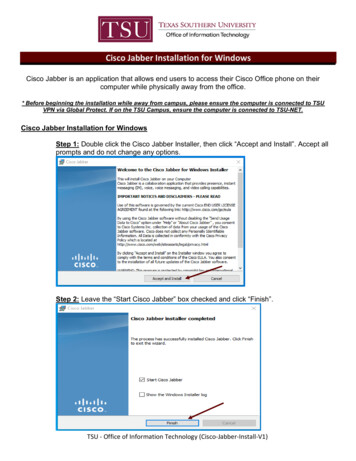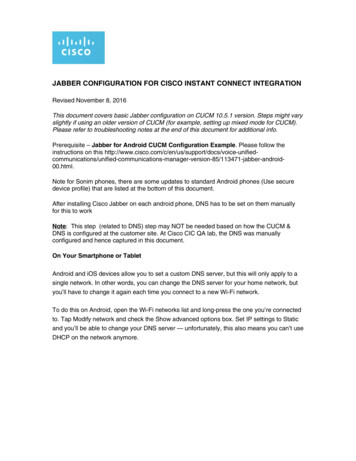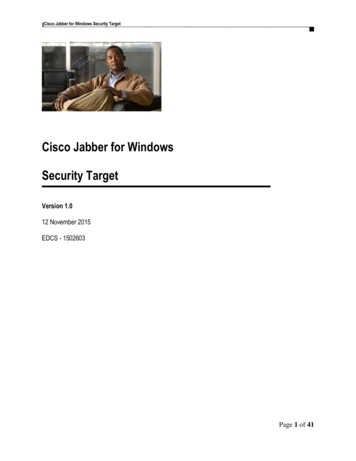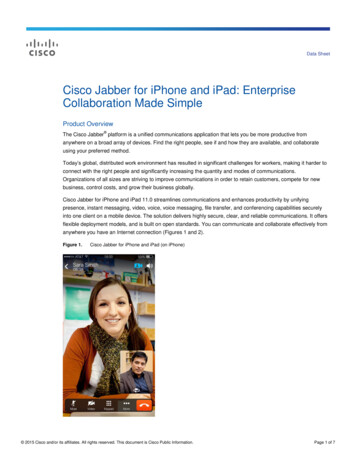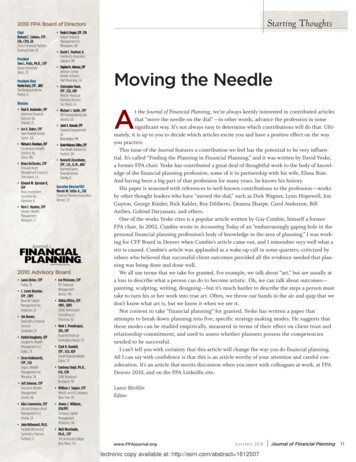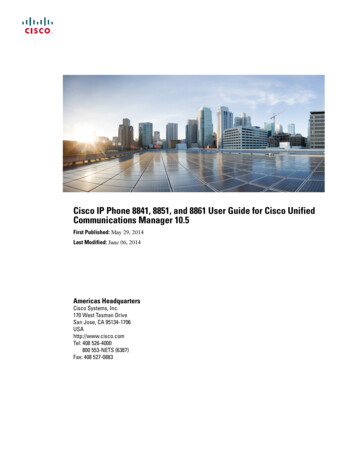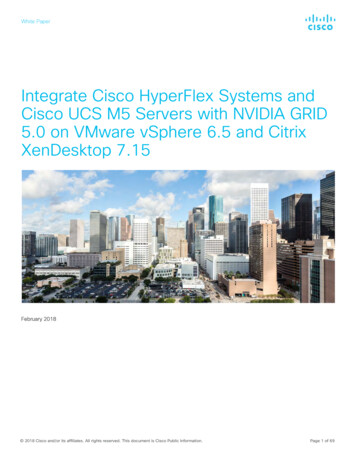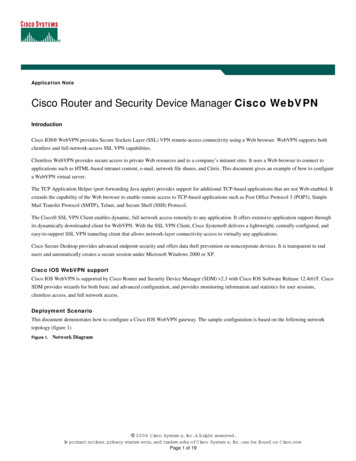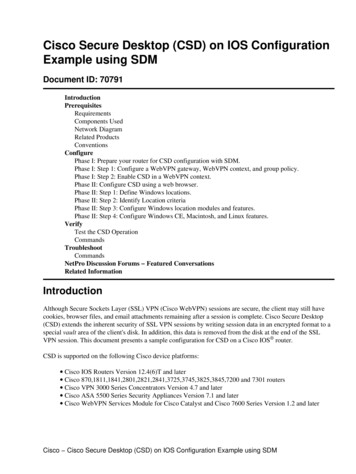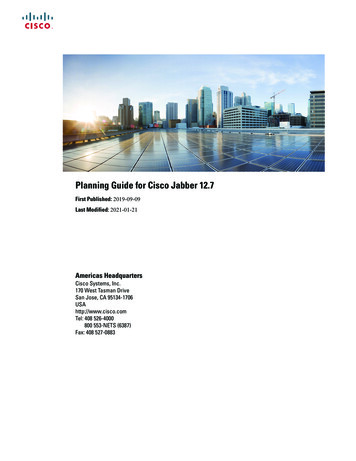
Transcription
Planning Guide for Cisco Jabber 12.7First Published: 2019-09-09Last Modified: 2021-01-21Americas HeadquartersCisco Systems, Inc.170 West Tasman DriveSan Jose, CA 95134-1706USAhttp://www.cisco.comTel: 408 526-4000800 553-NETS (6387)Fax: 408 527-0883
THE SPECIFICATIONS AND INFORMATION REGARDING THE PRODUCTS IN THIS MANUAL ARE SUBJECT TO CHANGE WITHOUT NOTICE. ALL STATEMENTS,INFORMATION, AND RECOMMENDATIONS IN THIS MANUAL ARE BELIEVED TO BE ACCURATE BUT ARE PRESENTED WITHOUT WARRANTY OF ANY KIND,EXPRESS OR IMPLIED. USERS MUST TAKE FULL RESPONSIBILITY FOR THEIR APPLICATION OF ANY PRODUCTS.THE SOFTWARE LICENSE AND LIMITED WARRANTY FOR THE ACCOMPANYING PRODUCT ARE SET FORTH IN THE INFORMATION PACKET THAT SHIPPED WITHTHE PRODUCT AND ARE INCORPORATED HEREIN BY THIS REFERENCE. IF YOU ARE UNABLE TO LOCATE THE SOFTWARE LICENSE OR LIMITED WARRANTY,CONTACT YOUR CISCO REPRESENTATIVE FOR A COPY.The Cisco implementation of TCP header compression is an adaptation of a program developed by the University of California, Berkeley (UCB) as part of UCB's public domain version ofthe UNIX operating system. All rights reserved. Copyright 1981, Regents of the University of California.NOTWITHSTANDING ANY OTHER WARRANTY HEREIN, ALL DOCUMENT FILES AND SOFTWARE OF THESE SUPPLIERS ARE PROVIDED “AS IS" WITH ALL FAULTS.CISCO AND THE ABOVE-NAMED SUPPLIERS DISCLAIM ALL WARRANTIES, EXPRESSED OR IMPLIED, INCLUDING, WITHOUT LIMITATION, THOSE OFMERCHANTABILITY, FITNESS FOR A PARTICULAR PURPOSE AND NONINFRINGEMENT OR ARISING FROM A COURSE OF DEALING, USAGE, OR TRADE PRACTICE.IN NO EVENT SHALL CISCO OR ITS SUPPLIERS BE LIABLE FOR ANY INDIRECT, SPECIAL, CONSEQUENTIAL, OR INCIDENTAL DAMAGES, INCLUDING, WITHOUTLIMITATION, LOST PROFITS OR LOSS OR DAMAGE TO DATA ARISING OUT OF THE USE OR INABILITY TO USE THIS MANUAL, EVEN IF CISCO OR ITS SUPPLIERSHAVE BEEN ADVISED OF THE POSSIBILITY OF SUCH DAMAGES.Any Internet Protocol (IP) addresses and phone numbers used in this document are not intended to be actual addresses and phone numbers. Any examples, command display output, networktopology diagrams, and other figures included in the document are shown for illustrative purposes only. Any use of actual IP addresses or phone numbers in illustrative content is unintentionaland coincidental.All printed copies and duplicate soft copies of this document are considered uncontrolled. See the current online version for the latest version.Cisco has more than 200 offices worldwide. Addresses and phone numbers are listed on the Cisco website at www.cisco.com/go/offices.Cisco and the Cisco logo are trademarks or registered trademarks of Cisco and/or its affiliates in the U.S. and other countries. To view a list of Cisco trademarks, go to this emarks.html. Third-party trademarks mentioned are the property of their respective owners. The use of the word partner does not imply apartnership relationship between Cisco and any other company. (1721R) 2021Cisco Systems, Inc. All rights reserved.
CONTENTSPREFACENew and Changed InformationixNew and Changed Information ixCHAPTER 1Requirements 1Server Requirements 1Operating System Requirements 2Operating Systems for Cisco Jabber for Windows 2Operating System for Cisco Jabber for Mac 3Operating Systems for Cisco Jabber for Android 3Operating Systems for Cisco Jabber for iPhone and iPad 4Hardware Requirements 4Hardware Requirements for Desktop Clients 4CTI Supported Devices 5Hardware Requirements for Cisco Jabber for iPhone and iPad5Hardware Requirements for Cisco Jabber for Android 6Network Requirements 15IPv6 Requirements 16Requirements to Support IPv6 in Android 19Ports and Protocols 19Supported Codecs 23Virtual Environment Requirements 24Audio and Video Performance Reference 24Media Assure 24Fast Lane Support 25Audio Bit Rates for Cisco Jabber Desktop Clients 25Audio Bit Rates for Cisco Jabber Mobile Clients 26Planning Guide for Cisco Jabber 12.7iii
ContentsVideo Bit Rates for Cisco Jabber Desktop Clients 26Video Bit Rates for Cisco Jabber for Android 26Video Bit Rates for Cisco Jabber for iPhone and iPad 27Presentation Video Bit Rates 27Maximum Negotiated Bit Rate 28Bandwidths 28Bandwidth Performance Expectations for Cisco Jabber Desktop Clients 28Bandwidth Performance Expectations for Cisco Jabber for Android 29Bandwidth Performance Expectations for Cisco Jabber for iPhone and iPad 30Video Rate Adaptation 30Call Management Records 31CHAPTER 2Deployment Scenarios33On-Premises Deployment 33On-Premises Deployment with Cisco Unified Communications Manager IM and Presence Service33Computer Telephony Integration 34On-Premises Deployment in Phone Mode 35Softphone 36Deskphone 36Extend and Connect 36Phone Mode with Contacts Deployment 36Cloud-Based Deployments 37Cloud-Based Deployment with Cisco Webex Messenger 38Hybrid Cloud-Based Deployment with Cisco Webex Messenger Service 39Hybrid Cloud-Based Deployment with Cisco Webex Platform Service 40Contacts in Jabber Team Messaging Mode 41Deployment in a Virtual Environment 42Virtual Environment and Roaming Profiles 42Deploying Jabber Softphone for VDI 43Remote Access 44Expressway for Mobile and Remote Access 44First Time Signing into Jabber Using Expressway for Mobile and Remote Access 44Supported Services 45Planning Guide for Cisco Jabber 12.7iv
ContentsCisco AnyConnect Deployments 51Deployment with Single Sign-On 52Single Sign-On Requirements 53Single Sign-On and Remote Access 54CHAPTER 3User Management 55Jabber IDs 55IM Address Scheme 56Service Discovery using Jabber IDs 56SIP URI 57LDAP User ID 57User ID Planning for Federation 57Proxy Addresses for User Contact Photos 57Authentication and Authorization 57Cisco Unified Communications Manager LDAP Authentication 57Cisco Webex Messenger Login Authentication 58Single Sign-On Authentication 58Certificate-Based Authentication for Cisco Jabber for iPhone and iPad 58Certificate-Based Authentication for Cisco Jabber for Android58Voicemail Authentication 59OAuth 59Multiple Resource Login 61CHAPTER 4Service Discovery63How the Client Connects to Services 63Cisco Webex Platform Service Discovery 63Cisco Webex Messenger Service Discovery 64Cisco Intercluster Lookup Service 64Expressway for Mobile and Remote Access Service Discovery 64Recommended Connection Methods 64Sources of Authentication 66How the Client Locates Services 67Method 1: Search For Services 69How the Client Discovers Available Services 69Planning Guide for Cisco Jabber 12.7v
ContentsClient Issues an HTTP Query for Cisco Webex Messenger Service 70Client Queries the Name Server 71Client Connects to Internal Services 71Client Connects through Expressway for Mobile and Remote Access 73Cisco UDS SRV Record 74Collaboration Edge SRV Record 76DNS Configuration 77How the Client Uses DNS 77Domain Name System Designs 78Method 2: Customization 81Service Discovery Customization 81Custom Installations for Cisco Jabber for Windows 81Custom Installations for Cisco Jabber for Mac, iPhone and iPad, and Android 82Method 3: Manual Installations 82High Availability 82High Availability for Instant Messaging and Presence 82Client Behavior During a Failover 83High Availability for Voice and Video 85High Availability for Persistent Chat 85High Availability for Contact Search and Contact Resolution 85High Availability for Voicemail 85Configuration Priorities 85Group Configurations Using Cisco Support Field 86CHAPTER 5Contact Source 87What is a Contact Source? 87Contact Source Servers 87Why Do I Need a Contact Source? 88When to Configure Contact Source Servers 88Contact Source Options for Cisco Directory Integration89Lightweight Directory Access Protocol 89How Cisco Directory Integration Works with LDAP 89Automatic Service Discovery—Recommended 89Manual Configuration for the LDAP Service 91Planning Guide for Cisco Jabber 12.7vi
ContentsLDAP Considerations 92Cisco Unified Communications Manager User Data Service94Contact Resolution with Multiple Clusters 95Extended UDS Contact Source 96LDAP Prerequisites 96LDAP Service Account 96Jabber ID Attribute Mapping 97Search Jabber IDs 97Local Contact Sources 98Custom Contact Sources 98Contact Caching 98Resolving Duplicate Contacts 98Dial Plan Mapping 99Cisco Unified Communication Manager UDS for Mobile and Remote Access 99Cloud Contact Source 100Cisco Webex Contact Source 100Contact Photo Formats and Dimensions 100Contact Photo Formats 100Contact Photo Dimensions 100Contact Photo Adjustments 101CHAPTER 6Security and Certificates103Encryption 103Compliance and Policy Control for File Transfer and Screen Capture 103Instant Message Encryption 103On-Premises Encryption 104Cloud-Based Encryption 105Encryption Icons 107Local Chat History 107Voice and Video Encryption 107Authentication Methods for Secure Media108PIE ASLR Support 108Federal Information Processing Standards 108Common Criteria 109Planning Guide for Cisco Jabber 12.7vii
ContentsSecure LDAP 110Authenticated UDS Contact Search 110Certificates 110Certificate Validation 110Required Certificates for On-Premises Servers 111Certificate Signing Request Formats and Requirements 112Revocation Servers 112Server Identity in Certificates 112Certificates for Multiserver SANs 113Certificate Validation for Cloud Deployments 113Server Name Indication Support for Multitenant Hosted Collaboration SolutionAntivirus Exclusions 114CHAPTER 7Configuration Management115Fast Sign-in 115CHAPTER 8Screen Share117Screen Share 117Cisco Webex Screen Share 117BFCP Screen Share 117IM Only Screen Share 118Escalate to a Meeting and Share 118CHAPTER 9Federation 119Interdomain Federation 119Intradomain Federation 119CHAPTERJabber Supported Languages 121APPENDIX A Supported LanguagesPlanning Guide for Cisco Jabber 12.7viii123114
New and Changed Information New and Changed Information, on page ixNew and Changed 2020ChangedUpdated required ports for Unity Connection Ports and ProtocolsAugust, 2020 ChangedNote on Samsung Galaxy Note devices.Hardware Requirements forCisco Jabber for AndroidMay, 2020ChangedChanges to how LDAP credentials areretrievedLDAP Service AccountFebruary2020ChangedAdded Windows user profile folders.Virtual Environment andRoaming ProfilesJanuary, 2020 ChangedDecember,2019Added a reference to the Cisco Meeting Server Ports for Other Services andRelease 2.6 and 2.7: Single CombinedProtocolsMeeting Server Deployments.ChangedAdded Croatian, Hungarian, Romanian,Slovak, and Turkish to supported languagesfor mobile clients.ChangedAdded requirement for port 3389 to support IM Only Screen ShareRDP.NewAdded information on antivirus exclusions.RemovedRemoved support for Survivable Remote Site Service DiscoveryTelephony because supported versions areEOL.Supported LanguagesAntivirus ExclusionsPlanning Guide for Cisco Jabber 12.7ix
New and Changed InformationNew and Changed InformationDateStatusSeptember,2019LocationInitial publicationChangedAdded support for 64-bit Android OS.Hardware Requirements forCisco Jabber for AndroidChangedAdded new Android supported devices.Hardware Requirements forCisco Jabber for AndroidChangedClarifications to service discovery process in Contact SourceLightweight Directory Access ProtocolPlanning Guide for Cisco Jabber 12.7xDescription
CHAPTER1Requirements Server Requirements, on page 1 Operating System Requirements, on page 2 Hardware Requirements, on page 4 Network Requirements, on page 15 Virtual Environment Requirements, on page 24 Audio and Video Performance Reference, on page 24Server RequirementsThe following software requirements are common to all Cisco Jabber clients in this release:ServiceSoftware RequirementSupported VersionIM and PresenceCisco Unified Communications 10.5(2) and later (Minimum)Manager IM and Presence Service11.5(1) SU2 or later (Recommended)Cisco Webex MessengerCisco Unified CommunicationsManager10.5(2) and later (Minimum)Contact SearchLDAP directoryLDAP v3 compliant directory such as MicrosoftActive directory 2008 R2 and Open LDAP 2.4 or laterVoicemailCisco Unity Connection10.5 and laterMultilineCisco Unified Contact CenterExpress11.6Telephony11.5(1) SU3 or later (Recommended)Planning Guide for Cisco Jabber 12.71
RequirementsOperating System RequirementsServiceSoftware RequirementSupported VersionConferencingCisco Meeting Server2.2 and laterCisco TelePresence Server3.1 and laterCisco TelePresence MCU4.3 and laterCisco ISR PVDM3Cisco Unified Communications Manager 9.x and laterCloud CMRCisco Webex Meetings Server with CollaborationMeeting RoomCisco Webex Meetings Server2.8 MR1 and laterCisco Webex Meetings CenterWBS33 and laterCisco Adaptive SecurityAppliance8.4(1) and laterRemote AccessOnly applies to Cisco Jabber forAndroid.Cisco AnyConnect SecureMobility ClientPlatform-dependentCisco Jabber for Android andCisco Jabber for iPhone and iPadclients only.Cisco Expressway CX8.10.1 and laterCisco Expressway EX8.10.1 and later.Cisco Jabber uses domain name system (DNS) servers during startup, DNS servers are mandatory for CiscoJabber setup.Operating System RequirementsOperating Systems for Cisco Jabber for WindowsYou can install Cisco Jabber for Windows on the following operating systems: Microsoft Windows 10 (desktop mode) Microsoft Windows 8.1 (desktop mode) Microsoft Windows 8 (desktop mode)Cisco Jabber for Windows does not require the Microsoft .NET Framework or any Java modules.Planning Guide for Cisco Jabber 12.72
RequirementsOperating System for Cisco Jabber for MacWindows 10 Servicing OptionsCisco Jabber for Windows supports the following Windows 10 servicing options: Current Branch (CB) Current Branch for Business (CBB) Long-Term Servicing Branch (LTSB)—with this option, it is your responsibility to ensure that anyrelevant service updates are deployed.For more information about Windows 10 servicing options, see the following om/en-us/library/mt598226(v vs.85).aspx.NoteCisco Jabber installs the required files to the following directories by default: %temp%\Cisco Systems\Cisco Jabber-Bootstrap.properties file and installation log %LOCALAPPDATA%\Cisco\Unified Communications-Logs and temporary telemetry data %APPDATA%\Cisco\Unified Communications-Cached configurations and account credentials %ProgramFiles%\Cisco Systems\Cisco Jabber-Installation files for x86 Windows %ProgramFiles(x86)%\Cisco Systems\Cisco Jabber-Installation files for x64 WindowsOperating System for Cisco Jabber for MacYou can install Cisco Jabber for Mac on the following operating systems: macOS Catalina 10.15 or later macOS Mojave 10.14 or later macOS High Sierra 10.13 (or later)Operating Systems for Cisco Jabber for AndroidRefer to the Play Store for the latest supported operating system version information.NoteCisco Jabber for Android is available as a 32-bit app and a 64-bit app. If your Android device has a 64-bitOS, you get a faster and richer experience by running the 64-bit Jabber client.Planning Guide for Cisco Jabber 12.73
RequirementsOperating Systems for Cisco Jabber for iPhone and iPadNoteIf Cisco Jabber is installed on Android 6.0 Marshmallow OS or later, and if it is kept idle: The network connection to Cisco Jabber is disabled. The users do not receive any calls or messages.Tap Change Settings and ignore battery optimization to receive calls and messages.Last Jabber Release for Android 5.x SupportCisco Jabber 12.8 is the last release that supports devices running Android 5.x.The next Jabber release will end support for all devices that cannot upgrade to Android 6.x.Operating Systems for Cisco Jabber for iPhone and iPadRefer to the App Store for the latest supported operating system version information.ImportantCisco supports only the current App Store version of Cisco Jabber for iPhone and iPad. Defects found in anyCisco Jabber for iPhone and iPad release are evaluated against current versions.Hardware RequirementsHardware Requirements for Desktop ClientsRequirementCisco Jabber for WindowsCisco Jabber for MacInstalled RAM2-GB RAM2-GB RAMFree physicalmemory128 MB1 GBFree disk space256 MB300 MBPlanning Guide for Cisco Jabber 12.74
RequirementsCTI Supported DevicesRequirementCisco Jabber for WindowsCisco Jabber for MacCPU speed and type AMD Mobile Sempron Processor 3600 Intel Core 2 Duo or later processors in any2 GHzof the following Apple hardware:Intel Core 2 Duo Processor T7400 @ 2.16 GHz iMac Pro MacBook Pro (including Retina Displaymodel) MacBook MacBook Air iMac Mac MiniI/O portsUSB 2.0 for USB camera and audiodevices.USB 2.0 for USB camera and audio devicesCTI Supported DevicesTo view the list of Computer Telephony Integration (CTI) supported devices for your Unified CommunicationsManager:1. From the Cisco Unified Reporting page, select Unified CM Phone Feature List from the SystemReports menu.2. After opening the report, select CTI controlled from the Feature drop-down list.Hardware Requirements for Cisco Jabber for iPhone and iPadThe following Apple devices are supported for Cisco Jabber for iPhone and iPad on iOS 11.X, iOS 12.X, andiOS 13.X. The devices that are not upgraded to these versions are not supported.Apple DeviceVersioniPad5th and 6th generationiPad AirAir 1, Air 2, and Air 3iPad Pro9.7 and 10.5 inch12.9 inch, 1st, 2nd and 3rd generationiPad miniMini 2, mini 3, mini 4, and mini 5iPhone5s, 6, 6 Plus, 6s, 6s Plus, 7, 7 Plus , 8, 8 Plus, X, Xs, XsMax,11, 11 Pro, 11 Pro Max, XR and SEiPod touch6th generationApple WatchWatchOS 5 running on Apple Watch and Apple Watch 2, 3and 4.Planning Guide for Cisco Jabber 12.75
RequirementsHardware Requirements for Cisco Jabber for AndroidThe following Bluetooth headsets are supported on iPhone and iPad:Table 1:ManufacturerModel(s)Cisco561, 562JabraBIZ 2400, Easygo, Evolve 65 UC Stereo, EXTREME 2,Motion1, PRO 9470, Speak 450 for Cisco, Speak 510, StealthSupreme UC, Wave JawboneICON for Cisco Bluetooth HeadsetPlantronicsVoyager Edge, Voyager Edge UC, Voyager Legend, VoyagerLegend UCSony ErikssonMW-6001Supports Bluetooth control for Cisco Jabber calls. This feature is only supported with firmware version3.72.Hardware Requirements for Cisco Jabber for AndroidMinimum requirements for Android devices:Android Operating SystemCPUDisplay5.0 or later1.5 GHz dual-coreFor two-way video: 480p x 800p orhigher.Recommended: 1.2-GHz quad-coreor higherFor IM only: 320p x 480p orhigher.Cisco Jabber for Android supports Full UC mode in the devices with these OS versions:Table 2: Supported Android DevicesDeviceModelMinimum Android OSVersionNotesBlackBerryPriv5.1If you remove Jabber from the recently viewed appslist and you keep the device idle for some time, thenJabber becomes inactive.FujitsuArrows M3576.0.1Planning Guide for Cisco Jabber 12.76
RequirementsHardware Requirements for Cisco Jabber for AndroidDeviceModelMinimum Android OSVersionGoogleNexus 45.1.1Nexus 55.0Nexus 5X6.0Nexus 65.0.2Nexus 6P6.0NotesFor Google Nexus 6P with Android OS version 6.xor 7.0, your administrator must set your Jabberphone service as a secure phone service. Otherwise,your device might not respond.No action is required for Android OS version 7.1 orlater.Honeywell DolphinNexus 75.0Nexus 95.0.2Nexus 105.0Pixel7.0Pixel C6.0Pixel XL7.0Pixel 28.0During a Jabber call, if the user switches audio fromthe mobile device to a headset, momentary audioissues are possible.Pixel 2 XL8.0During a Jabber call, if the user switches audio fromthe mobile device to a headset, momentary audioissues are possible.Pixel 38.0If you use the attached headset with the phone, thenthere might be some issues with the audio for fewseconds.Pixel 3 XL8.0If you use the attached headset with the phone, thenthere might be some issues with the audio for fewseconds.CT505.0CT407.1.1CT607.1.1 and 8.1We only support the CT60 with Android OS 7.1.1and 8.1.Planning Guide for Cisco Jabber 12.77
RequirementsHardware Requirements for Cisco Jabber for AndroidDeviceModelMinimum Android OSV
PlanningGuideforCiscoJabber12.7 FirstPublished:2019-09-09 LastModified:2021-01-21 AmericasHeadquarters CiscoSys
